Meu SciELO
Serviços Personalizados
Journal
Artigo
Indicadores
-
 Citado por SciELO
Citado por SciELO -
 Acessos
Acessos
Links relacionados
-
 Citado por Google
Citado por Google -
 Similares em
SciELO
Similares em
SciELO -
 Similares em Google
Similares em Google
Compartilhar
Enfermería Global
versão On-line ISSN 1695-6141
Enferm. glob. vol.21 no.68 Murcia Out. 2022 Epub 28-Nov-2022
https://dx.doi.org/10.6018/eglobal.512491
Originals
Logistic model of factors associated with Burnout Syndrome in health personnel
1César Vallejo University, Infectious and Communicable Diseases Research Group. Trujillo, Peru
2César Vallejo University, School of Psychology. Trujillo, Peru.
3Private University of the North, Department of Sciences. Trujillo, Peru.
Introduction:
Excessive workload in health personnel, due to the COVID-19 pandemic, has generated the presence of Burnout Syndrome. The purpose of this study was to determine a logistic model for the factors associated with the dimensions of Burnout Syndrome in health personnel during the COVID-19 pandemic in Trujillo - Peru.
Method:
A cross-sectional, correlational design was applied. The standardized Maslach Burnout Inventory questionnaire was used and applied virtually. It measures emotional exhaustion, depersonalization and personal fulfillment. The sample consisted of 143 health professionals from the Trujillo Micro-network and Social Health Insurance establishments (ESSALUD).
Results:
24.5% of health professionals have a high level of emotional exhaustion, 27.3% a high level of depersonalization and 39.9% a low level of personal fulfillment. Marital status, family income, type of institution where they work, age and number of children are associated with the level of emotional exhaustion (p<0.05). Gender, profession, type of institution, age and number of children are associated with the level of depersonalization (p<0.05). The type of institution and age are associated with the level of personal fulfillment (p<0.05).
Conclusions:
The proposed ordinal logistic model indicates 69.2% success in emotional exhaustion level, 60.8% success for depersonalization level and 58.7% with the model for personal fulfillment level.
Keywords: (Source: MeSH) Burnout syndrome; healthcare personnel; COVID-19 (Source: MeSH)
INTRODUCTION
The COVID-19 pandemic has caused an increasing burden on medical services in both developed and developing countries. The shortage of human and non-human resources for patient care resulted in a marked increase in the workload of health professionals. This could lead to an increase in mental health problems in health care personnel 1.
Burnout syndrome is a multifactorial pathology (physical, psychological and emotional), resulting from chronic work-related stress, and is manifested in 3 dimensions: emotional exhaustion, depersonalization and personal fulfillment (2)(3)(4).
Emotional exhaustion is a negative emotional reaction to work as a consequence of prolonged exposure to a stressful work environment 5. Depersonalization is a psychological state in which the professional can generate attitudes of indifference, egocentrism, demotivation, among others. Personal fulfillment consists of a decrease or even loss of self-esteem at work 6.
Studies in different parts of the world show that this health problem has a worldwide incidence. Thus, in a study carried out among health personnel in Spain, 38.9% reported high levels of depersonalization, 43.3% indicated that they might need psychological treatment in the future, and 85.4% said that the lack of personal protective equipment (PPE) resulted in increased stress and anxiety. The binary logistic model analyzed determined that variables such as professional category and the subjective perception of needing psychological or psychiatric treatment in the future are those associated with emotional exhaustion 7.
In Turkey, it was shown that there were no significant differences between the levels of emotional exhaustion according to gender and marital status. However, in the age variable there were, as older physicians were those who had higher levels of burnout compared to younger ones. The level of personal fulfillment of physicians who voluntarily chose their profession was higher than those who did not, and physicians who actively fought the pandemic had a lower level of total burnout than those who were not active 8.
In China, two studies were found: one of them reported that the anxiety rate of health personnel was higher in women than in men; however, it was lower among physicians than in nurses 9. In the other study, a positive correlation between occupational stress and burnout was observed in surgical nurses, who had high scores. In addition, they were identified as risk factors for quality of life 10.
In Canada and South Korea, they determined that the presence of Burnout, among other job demands, influences intentions to leave the job and is related to health problems 11,12.
In Chile, 169 public health professionals were analyzed, resulting in 10.7% of them with high levels of Burnout, 88.8% at Medium/Moderate level, with the highest scores in the dimension of personal fulfillment and emotional exhaustion 13.
In Peru, a study found that professional burnout in physicians and nurses in 7 cities reached 5.5% prevalence; the associated factors were: having a medical profession, being male, having family separation, being dissatisfied with their work schedule, having an aggravated or work-related illness, and working in level III health facilities14. Another study carried out in Peru (Arequipa), confirms that nurses present Burnout Syndrome at considerable levels, and this is associated with the length of service they have been providing 15.
The above reflects the importance of establishing a logistic regression for a better understanding of the factors that come together to explain Burnout Syndrome in healthcare professionals.
The general objective of the present study was to determine a logistic model for the factors associated with the dimensions of Burnout Syndrome in healthcare personnel during the COVID-19 pandemic in Trujillo, Peru.
The specific objectives were to identify social factors such as gender, age, marital status, number of children, family income, specialty, profession, and length of service associated with the dimensions of Burnout Syndrome; to identify demographic factors such as type of institution, category of health facility associated with the dimensions of Burnout Syndrome; to identify whether presenting chronic illness is associated with the dimensions of Burnout Syndrome and, finally, to estimate the degree of fit of the model to predict the dimensions of Burnout Syndrome in healthcare personnel during the COVID-19 pandemic in Trujillo - Peru.
MATERIAL AND METHOD
The type of study was quantitative with a cross-sectional, correlational design 16.
The population consisted of health professionals such as physicians, nurses, nutritionists and medical technologists, who are treating COVID-19 patients in the facilities of the Micro network of Trujillo and the Social Security Healthcare Network (ESSALUD) in the city of Trujillo. The data were collected from June to August 2021.
To determine the number of professionals, the data provided by the Ministry of Health in the La Libertad region were taken into account; however, as the work was carried out with professionals from the city of Trujillo (which belongs to this region), an unknown population was considered for the sample estimation, with a confidence of 95%, 8% error and a prevalence of Burnout Syndrome of 50%, obtaining a sample of 143 health professionals. For the estimation of the number of health professionals, it was considered proportional to the population of health workers according to specialty at the regional level and taking into account the accessibility of the information, the sampling was taken by convenience, obtaining a sample of 76 physicians, 36 nurses, 22 nutritionists and 9 technologists 17.
All healthcare workers from the healthcare facilities who agreed to participate in the study and who had direct contact with the COVID-19 patients were included. Likewise, when performing the quality control of the information obtained, forms with errors and incomplete were excluded.
For data collection, the technique used was the survey and the instrument was a questionnaire, which was made up of 2 parts 16. The first part asked about social factors such as gender, age, marital status, number of children, family income, specialty, profession and time in service of the participants; demographic factors such as type of institution, category of health facility (according to the classification of the Ministry of Health) 17 and whether the patient has any comorbidity.
The second part included the Maslach Burnout Inventory (MBI-HSS), which contains 22 items and is composed of three subscales: emotional exhaustion, depersonalization and personal fulfillment; the response options range from 0 (never) to 6 (every day). This questionnaire has been adapted to Spanish and validated by Gil-Monte and Peiró (1999), who explored the three-factor structure of the scale, with a total variance of 43% and factor loads greater than 0.40; The reliability by the Alpha index was greater than 0.70. In addition, psychometric evidence in Chilean professionals confirmed the 3-dimensional structure, with fit indexes higher than 0.90, factor loads higher than 0.47 and Alpha indexes between 0.72 and 0.86 18.
For the statistical analysis, the Excel program was first used to prepare the database, which was then exported to the SPSS version 27 statistical program. A descriptive bivariate analysis was applied to the variables entered and inferential statistics using statistical tests such as Chi-Square or equivalent association tests for qualitative variables. Also, taking into account that the dependent variable is ordinal, the ordinal logistic models were used (prior verification of the assumptions), determining whether the model found is significant. After that, the variables that entered the model were analyzed, identifying the R2 determination coefficients, as well as the correct forecast percentage 19,20.
This research was approved by the ethics committee of the Faculty of Health Sciences of the Universidad César Vallejo (Report 009-CE-FCS-UCV-21), and the identity of the workers surveyed was kept anonymous. Each participant gave informed consent prior to the application of the questionnaire.
RESULTS
Table 1: Factors associated with the level of Emotional Exhaustion of Burnout Syndrome in healthcare personnel during the COVID-19 pandemic, Trujillo - Peru.
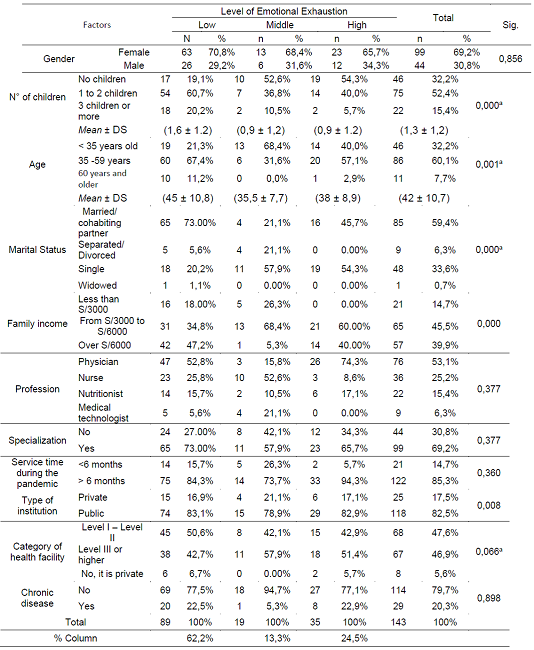
Source: Maslach questionnaire database applied to healthcare personnel.
Note:The variables were entered into an ordinal logit model, (X2 = 42.05, p < 0.001),
Nagelkerke (R2 = 0.30) Cox and Snell (R2 = 0.26), and McFadden (R2 = 0.16).
aGamma test was applied
In Table 1 we can see that the majority of health professionals have a low level of emotional exhaustion, 62.2%; however, there is a percentage of them who have a high level, 24.5%. Within the characteristics of the professionals with a high level of burnout we find, sex: female, marital status: single, family income: 3000 to 6000 soles, profession: physicians, with specialization, more than 6 months of service, work in public institutions at level III or higher, do not have a chronic disease, have an average age of 38 years and have 1 child. In the bivariate analysis, there is statistical evidence to affirm that the number of children, age, marital status, family income and type of institution where they work are associated with the level of emotional exhaustion (p < 0.05).
Table 2: Factors associated with the depersonalization level of Burnout Syndrome in healthcare personnel during the COVID-19 pandemic, Trujillo - Peru.
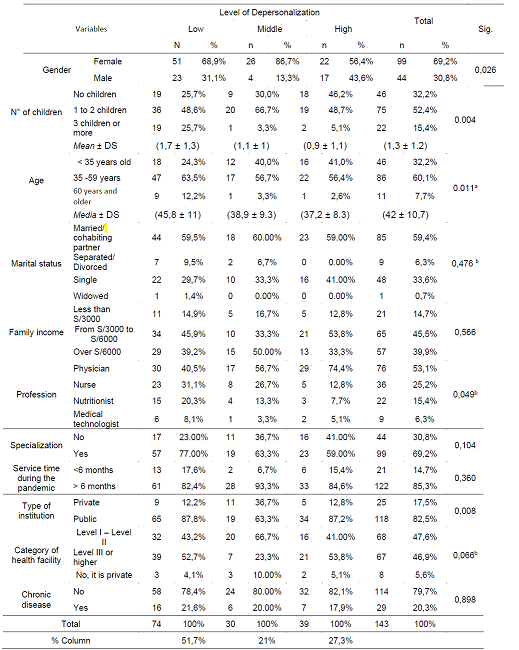
Source: Maslach questionnaire database applied to healthcare personnel.
Note:Variables were entered into an ordinal logit model, (X2 = 43.46, p < 0.05), Nagelkerke (R2 = 0.30) Cox and Snell (R2 = 0.26), and McFadden (R2 = 0.15).
aGamma test was applied
bCramer's V test was applied
In Table 2 we can see that the majority of health professionals have a low level of Burnout Syndrome depersonalization, 51.7%; however, there is a percentage of them who have a high level, 27.3%. Within the characteristics of the professionals with a high level of depersonalization we find, sex: female, marital status: married, family income: 3000 to 6000 soles, profession: physicians, with specialization, more than 6 months of service, work in public institutions at level III or higher, do not have a chronic disease, have an average age of 37 years and have 1 child. In the bivariate analysis, there is statistical evidence to affirm that gender, number of children, age, profession and type of institution are associated with the level of depersonalization (p < 0.05).
Table 3: Factors associated with the level of personal fulfillment of Burnout Syndrome in healthcare personnel during the COVID-19 pandemic, Trujillo - Peru.
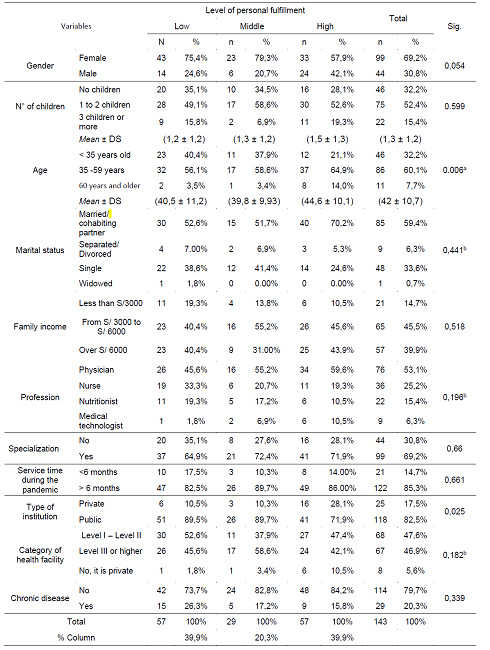
Source: Maslach questionnaire database applied to healthcare personnel.
Note:Variables were entered into an ordinal logit model, (X2 = 39.30, p < 0.05), Nagelkerke (R2 = 0.273) Cox and Snell (R2 = 0.24), and McFadden (R2 = 0.13).
aGamma test was applied
bCramer's V test was applied
Table 3 shows that 39.9% of health professionals have a low level of personal fulfillment of Burnout Syndrome. Within the characteristics of these professionals we find, gender: female, married, family income of 3000 soles or more, medical profession, with specialization, with more than 6 months of service during the pandemic, working in public institutions at level I and II, no chronic disease, with an average age of 40.5 and 1 child. In the bivariate analysis, there is statistical evidence to affirm that age and type of institution are associated with the level of personal fulfillment (p < 0.05).
Table 4: Ordinal logistic regression model for the levels of Burnout Syndrome dimensions in healthcare personnel during the COVID-19 pandemic, Trujillo - Peru.
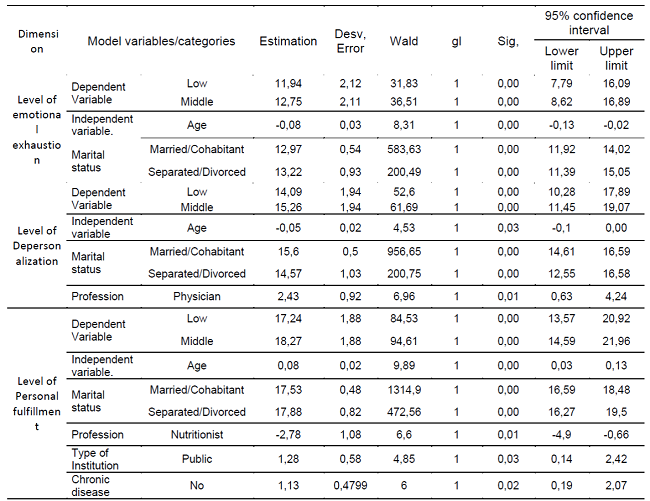
Source: Maslach questionnaire database applied to healthcare personnel.
The ordinal regression model, with logit link function, for the levels of the Burnout Syndrome dimensions, is shown in Table 4, after joint evaluation of the assumptions, the goodness-of-fit test and the R2 coefficients of determination, shown in the previous Tables. Here it was possible to determine that the models were significant, entering the variables age, marital status married/cohabitant, separated/divorced for the three dimensions; in the model of the depersonalization dimension, the medical profession is added and for the level of personal fulfillment, the nutritionist profession, type of public institution and no chronic disease are added.
Table 5: Predicted level of Burnout dimensions with ordinal regression models of Burnout Syndrome in healthcare personnel during the COVID-19 pandemic, Trujillo - Peru.
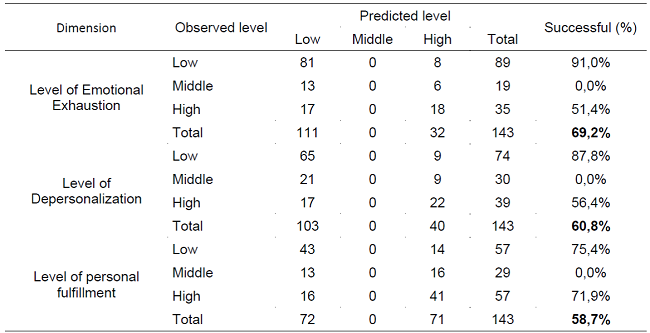
Source: Maslach questionnaire database applied to healthcare personnel
Table 5 relates the level of achievement predicted with the level of achievement observed in the Burnout Syndrome dimensions, elaborated using the forecast provided by SPSS, as in logistic regression, finding 69.2% success with the ordinal regression model in emotional exhaustion level, 60.8% success with the depersonalization level model and 58.7% with the personal fulfillment level model.
DISCUSSION
The data collected in the research show that Burnout Syndrome in health professionals in the city of Trujillo-Peru, was evidenced in only 6.3% of them. However, when analyzing by dimensions, it can be seen that 24.5% have a high level of emotional exhaustion, coinciding with a study conducted in India, which points to burnout as an important occupational problem among health care professionals, especially during the COVID-19 pandemic 21. A similar result was also found in a sample of health professionals in the city of Arequipa-Peru, where 5.6% of severe cases of Burnout Syndrome were found 22.
Regarding the level of depersonalization, 27% of health personnel in Trujillo had a high level of depersonalization, something close to the study carried out in Cusco-Peru where this same level was found in 33.6% of the personnel in the emergency area of a public hospital (23). Likewise, in Russia, 38% of health workers have become more insensitive towards people since they took this job during the pandemic 24. Besides, the characteristics found of these professionals affected in this dimension of Burnout Syndrome coincide with a study in Ecuador, which indicates that most of them are doctors, married and work in public institutions 6.
It is important to mention that in the dimensions of exhaustion and depersonalization, the majority of healthcare professionals were found with more than 6 months of service, aged close to 40 years and working in public institutions of level III, similar to a study conducted in seven cities in Peru 14. This would be supported by the fact that when COVID-19 cases reached their highest peak, these hospitals were the most overloaded, lacking the necessary implements to combat the pandemic, generating fatigue and demotivation in health professionals who faced this situation on a daily basis.
In the bivariate analysis, one of the characteristics associated with depersonalization is the profession, and a study conducted in Spain also confirms that doctors and nurses are at greater risk of suffering emotional exhaustion than other professionals, since they devote more time to patients performing the most elementary care with basic needs 7. Other characteristics associated with depersonalization are age and female sex, similar to the study conducted in Brazil 25, but different from the multiple linear regression study conducted on physicians residing in the United States, which concluded that being male is a characteristic that influences depersonalization 26.
The findings also show that 40% of professionals have a low level of personal fulfillment, with characteristics similar to those found in studies carried out in Ecuador and Colombia, where most of the healthcare workers practice in public institutions and have more time of service. This could be explained by the fact that these professionals feel that the time devoted to their work does not meet their personal expectations and they are demotivated 6,27.
The joint evaluation of the factors yielded significant models for the three dimensions (p<0.05). The level of emotional exhaustion is explained by age and marital status; age in the inverse sense would explain that younger professionals tend to have greater emotional exhaustion in Trujillo. The level of depersonalization is explained by age, marital status and the profession of physician, unlike the model proposed by a study in Spain where the emotional exhaustion dimension is explained only by the profession of physician and nurse, so we agree on the need to consider specific mental health care services and crisis training to avoid possible psychological disorders 7.
Personal fulfillment in the health professionals analyzed, according to the model, is explained by age, marital status: married/cohabiting, separated/divorced, profession: nutritionist, type of institution and not having a chronic disease. This can be explained by the fact that health professionals in this pandemic were affected, dedicating a large part of their time only to combat it, and in many cases with insufficient resources for individual protection, putting their personal and family health at risk. On the other hand, in the case of the nutritionists, it entered as an inverse factor in the model because these professionals had less exposure to working with COVID-19 patients, having remote work, generating low levels of personal fulfillment 28.
In Chile they also worked on a linear regression model for Burnout Syndrome, entering variables such as intrinsic motivation and years of service and a multivariate logistic model, where age turned out to be a protective factor and having children a risk factor for this disease, coinciding in part with our results 13,29.
The information obtained is of vital importance for the development of future protocols and training of healthcare personnel to deal with an emergency pandemic environment. In Trujillo-Peru, it is important to have the physical means for their protection, as well as updated and accurate information to avoid uncertainty, preventing mental health diseases in healthcare professionals.
The main limitation for the present study was to reach a larger sample size; however, robust statistical tests were used to allow the results to be generalizable at the population level and it was observed that an ordinal logistic regression model was determined for each of the dimensions of Burnout Syndrome. In addition, it is important to take into account the context of the difficulty in administering the questionnaire, considering it opportune to carry out this type of study at a historical moment such as the one in which we are facing this pandemic.
CONCLUSIONS
Social factors associated with emotional exhaustion were found to be marital status, family income, age and number of children; gender, profession, age and number of children were found to be associated with depersonalization; and only age was associated with personal fulfillment.
Of the demographic factors, only the type of institution is associated with all three dimensions of Burnout Syndrome.
The presence or absence of chronic illness is not associated with any of the dimensions of Burnout Syndrome.
Regarding the multivariate analysis, the degree of adjustment of each of the models was significant for predicting the dimensions of Burnout Syndrome in healthcare personnel during the COVID-19 pandemic in Trujillo, Peru.
REFERENCIAS
1. Abdelhafiz AS, Ali A, Ziady HH, Maaly AM, Alorabi M, Sultan EA. Prevalence, Associated Factors, and Consequences of Burnout Among Egyptian Physicians During COVID-19 Pandemic. Front Public Heal. 2020;8: 590190 (1-9). doi: 10.3389/fpubh.2020.590190 [ Links ]
2. Lovo J. Síndrome de burnout: Un problema moderno. Entorno. 2020;(70):110-20. doi: 10.5377/entorno.v0i70.10371 [ Links ]
3. Jalili M, Niroomand M, Hadavand F, Zeinali K, Fotouhi A. Burnout among healthcare professionals during COVID-19 pandemic: a cross-sectional study. Int Arch Occup Environ Health. 2021; 94:1345-1352. doi: 10.1007/s00420-021-01695-x [ Links ]
4. Dimitriu MCT, Pantea-Stoian A, Smaranda AC, Nica AA, Carap AC, Constantin VD, et al. Burnout syndrome in Romanian medical residents in time of the COVID-19 pandemic. Med Hypotheses. 2020; 144:10-22. doi: 10.1016/j.mehy.2020.109972 [ Links ]
5. De Arco LK, Castillo JA. Síndrome de Burnout en época de pandemia: caso colombiano. Interconectando Saberes. 2020;(10):115-23. doi: 10.25009/is.v0i10.2675 [ Links ]
6. Torres FG, Irigoyen V, Moreno AP, Ruilova EA, Casares J, Mendoza M. Burnout syndrome in health professionals in Ecuador and associated factors in times of pandemic. Rev Virtual la Soc Paraguaya Med Interna. 2021;8(1):126-36. doi: 10.18004/rvspmi/2312-3893/2021.08.01.126 [ Links ]
7. Martínez J, Lázaro C, Gómez J, Fernández M. Psychological Impact of COVID-19 Emergency on Health Professionals: Burnout Incidence at the Most Critical Period in Spain. J Clin Med. 2020; 9(9):3029. doi:10.3390/jcm9093029 [ Links ]
8. Dinibutun S. Factors associated with burnout among physicians: An evaluation during a period of COVID-19 pandemic. J Healthc Leadersh. 2020; 12:85-94. doi: 10.2147/JHL.S270440 [ Links ]
9. Lozano A. Impacto de la epidemia del Coronavirus (COVID-19) en la salud mental del personal de salud y en la población general de China. Rev Neuropsiquiátrica. 2020; 83(1):51-6. doi:10.20453/rnp.v83i1.3687 [ Links ]
10. Li X, Jiang T, Sun J, Shi L, Liu J. The relationship between occupational stress, job burnout and quality of like among surgical nurses in Xinjian, China. BMC Nursing. 2021; 20: 181. doi: 10.1186/s12912-021-00703-2 [ Links ]
11. Chênevert D, Kilroy S, Johnson K, Fournier PL. The determinants of burnout and professional turnover intentions among Canadian physicians: application of the job demands-resources model. BMC Health Serv Res. 2021; 21: 993. doi: 10.1186/s12913-021-06981-5 [ Links ]
12. Lee JY, Kim M, Jhon M, Kim H, Kang HJ, Ryu S, et al. The association of gratitude with perceived stress among nurses in Korea during COVID-19 outbreak. Arch Psychiatr Nurs. 2021;35(6):647-52. doi: 10.1016/j.apnu.2021.10.002 [ Links ]
13. Salgado-Roa JA, Leria-Dulcic FJ. Burnout, satisfacción y calidad de vida laboral en funcionarios de la salud pública chilenos. Univ y Salud. 2019;22(1):06-16. doi: 10.22267/rus.202201.169 [ Links ]
14. Solís-Cóndor R, Tantalean-Del Águila M, Burgos-Aliaga R, Chambi-Torres J. Agotamiento profesional: prevalencia y factores asociados en médicos y enfermeras en siete regiones del Perú. An la Fac Med. 2017; 78(3):270-6. doi: 10.15381/anales.v78i3.13757 [ Links ]
15. Carrasco Crivillero OP, Castillo Saavedra EF, Salas Sánchez RM, Reyes Alfaro CE. Estresores laborales y satisfacción en enfermeras peruanas durante la pandemia de COVID - 19. Scielo [Internet]. 2020; 1-14. doi: 10.1590/SciELOPreprints.1468 [ Links ]
16. Manterola C, Quiroz G, Salazar P, García N. Metodología de los tipos y diseños de estudio más frecuentemente utilizados en investigación clínica. Rev Med Clin Condes. 2019; 30(1):36-49. doi: 10.1016/j.rmclc.2018.11.005 [ Links ]
17. Ministerio de Salud. Información de recursos humanos en el sector salud en el marco de la pandemia COVID-19, Perú 2020 [Internet]. Lima: MINSA; 2020 [citado 15 de enero de 2022]. Disponible en: http://digep.minsa.gob.pe/publicaciones/bibliograficos/libro32/32.html [ Links ]
18. Olivares-Faúndez VE, Mena-Miranda L, Jélvez-Wilke C, Macía-Sepúlveda F. Validez factorial del Maslach Burnout Inventory human services (MBI-HSS) en profesionales Chilenos. Univ Psychol. 2014;13(1):145-59. Doi: 10.11144/javeriana.upsy13-1.vfmb [ Links ]
19. Castro M. Bioestadística aplicada en investigación clínica: conceptos básicos. Rev Med Clin Condes. 2019; 30(1):50-65. doi: 10.1016/j.rmclc.2018.12.002 [ Links ]
20. Hosmer DW, Lemeshow S, Sturdivant R. Applied Logistic Regression 3ed. West Point, The United States of America: A Wiley Interscience Publication; 2013. doi: 10.1002/9781118548387.ch1 [ Links ]
21. Sultana A, Sharma R, Hossain MM, Bhattacharya S, Purohit N. Burnout among healthcare providers during COVID-19: Challenges and evidence-based interventions. Indian J Med Ethics. 2020; 5(4):308-11. doi: 10.20529/IJME.2020.73 [ Links ]
22. Arias Gallegos W, Muñoz del Carpio Toia A, Delgado Montesinos Y, Ortiz Puma M, Quispe Villanueva M. Síndrome de burnout en personal de salud de la ciudad de Arequipa (Perú). Med Segur Trab (Madr) [Internet]. 2017 [citado 15 de enero de 2022];63(249):331-44. Disponible en: https://scielo.isciii.es/scielo.php?script=sci_arttext&pid=S0465-546X2017000400331 [ Links ]
23. Sarmiento Valverde GS. Burnout en el servicio de emergencia de un hospital. Horiz Médico. 2019;19(1):67-72. doi: 10.24265/horizmed.2019.v19n1.11 [ Links ]
24. Mosolova E, Sosin D, Mosolov S. Stress, anxiety, depression and burnout in frontline healthcare workers during two peaks of COVID-19 pandemic in Russia. Psychiatry Research, 2021; 306: 114226. doi: 10.1016/j.psychres.2021.114226 [ Links ]
25. De Paiva LC, Gomes Canário AC, Corsino de Paiva China EL, Gonçalves AK. Burnout syndrome in health-care professionals in a university hospital. Clinics [Internet]. 2017 [citado 15 de enero de 2022];72(5):305-9. Disponible en: https://www.ncbi.nlm.nih.gov/pmc/articles/PMC5439116/ [ Links ]
26. Nituica C, Bota OA, Blebea J, Cheng CI, Slotman GJ. Factors influencing resilience and burnout among resident physicians - a National Survey. BMC Med Educ. 2021;21(1):514 (1-9). doi: 10.1186/s12909-021-02950-y [ Links ]
27. Muñoz-Cerón JF, Gallo Eugenio LM, Figueroa Vargas DA. Síndrome de burnout en los neurólogos colombianos: prevalencia y factores asociados. Acta Neurológica Colomb [Internet]. 2021 [citado 15 de enero de 2022];37(2):63-8. Disponible en: http://www.scielo.org.co/scielo.php?script=sci_arttext&pid=S0120-87482021000300063 [ Links ]
28. Monterrosa-Castro A, Dávila-Ruiz R, Mejía-Mantilla A, Contreras-Saldarriaga J, Mercado-Lara M, Flores-Monterrosa C. Estrés laboral, ansiedad y miedo al COVID-19 en médicos generales colombianos. MedUNAB. 2020;23(2):195-213. https://doi.org/10.29375/01237047.3890 doi:10.29375/01237047.3890 [ Links ]
29. Muñoz N, Campaña N, Campaña G. Prevalencia del síndrome de Burnout en los residentes de cirugía general de Chile y sus factores asociados. Rev Chil Cir [Internet]. 2018 [citado 15 de enero de 2022];70(6):544-50. Disponible en: https://www.scielo.cl/scielo.php?script=sci_arttext&pid=S0718-40262018000600544 [ Links ]
Received: February 24, 2022; Accepted: July 08, 2022











 texto em
texto em 


